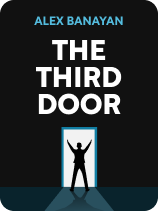

This article is an excerpt from the Shortform book guide to "The Third Door" by Alex Banayan. Shortform has the world's best summaries and analyses of books you should be reading.
Like this article? Sign up for a free trial here.
Do you tend to give up when you don’t reach a breakthrough right away? What’s the best way to find a solution without wasting a lot of time?
In The Third Door, Alex Banayan shares the insights into success that he learned from interviewing inventor Dean Kamen. Kamen’s secret is kissing frogs—in other words, persistently trying lots of solutions. Kamen cautions, though, that this must be done strategically so that you don’t waste time.
Keep reading to learn how kissing frogs might be your ticket to success as it has been for Kamen.
Kissing Frogs
Dean Kamen gave Banayan insights on how to be strategically persistent so as to be efficient. Kamen invented the Segway and scores of other products, from insulin pumps to water purifiers. He held over 400 patents, was a member of the National Inventors Hall of Fame, and produced a TED Talk that garnered over a million views.
(Shortform note: Kamen is best known for his invention of the self-balancing, two-wheeled Segway, which, as Adam Grant explores in Originals, he developed after a long track record of other remarkable inventions. The product immediately attracted high-profile investors including Steve Jobs and Jeff Bezos, but, while it was hailed as a technological breakthrough, and remains Kamen’s most recognized invention, it was a commercial flop—it didn’t answer a customer need and was too expensive for the mass market. Kamen remains better regarded as an inventor than a business person.)
As an inventor, Kamen lived persistence: trying things that failed until discovering something that worked. He came up with a metaphor for persistence: kissing frogs. Based on the princess and the frog fairy tale, it describes a mentality by which you kiss frogs (potential solutions to your problem) until one of them reveals itself as a prince—the right solution.
(Shortform note: Kamen’s metaphor of kissing frogs has become popular with business strategists, but some note that a better metaphor, especially for large companies, would be picking horses. The idea is that a kissing frogs approach might work for inventors like Kamen who pursue a wide range of ideas (evidenced by the variety of inventions he’s come up with), but is unsustainable for larger companies: Trying out countless ideas can mean resources get spread too thinly. Instead, a more efficient approach is to examine potential ideas for feasibility and then devote enough resources to those ideas that they stand a good chance of success.)
Though Kamen encourages people to kiss many frogs, he acknowledges no one has the time or resources to kiss every frog available. He offered advice on how to kiss frogs, or pursue ideas, as efficiently as possible.
First, ask yourself if your goal is truly feasible: Does it contradict a law of physics? Is there a fundamental flaw in your product’s idea? For example, are you offering a service that solves a problem no one cares about? Examining your idea for feasibility will prevent you from wasting time pursuing an inherently unworkable solution.
(Shortform note: Business strategists say that one of the main things to consider when judging your idea’s feasibility is its potential market, which aligns with Kamen’s advice to ask whether you’re solving a problem no one has. Then, even if your product does solve a problem, you must consider whether it’s a problem people are willing to pay to fix, or if it’s a market segment that’s growing or shrinking.)
Then, sort your “frogs” into categories, so that instead of blindly kissing every frog possible, you can eliminate swaths of frogs by determining if a type of frog is unworkable. This will save you time.
(Shortform note: Categorizing your frogs—your ideas—by topic can also help you see new ideas: Labels and lists can provide a framework that sparks creativity and helps you spot connections between ideas, projects, and goals.)
Finally, if you’re having trouble finding the right frog, rethink the questions you’re asking. If you come at your problem from a new direction, the solution may appear. As an example, Kamen described a project he was tapped to help with: how to introduce more science into schools’ curriculums. While most people saw it as a funding issue or a hiring problem, he viewed it as a cultural problem, and he set out to change students’ attitudes toward science by introducing engineering competitions (under the FIRST program) and positioning scientists as celebrities. By rethinking what the underlying problem was, he was able to devise an effective solution, and his programs have improved science curriculums around the world.
(Shortform note: Kamen has referred to the FIRST program as the invention he’s proudest of as it will help shape the world: Kids who pass through the program today will develop world-changing technology for tomorrow’s problems. The program, which has become the global leading not-for-profit STEM program for students, is built around Kamen’s advice that he gave to Banayan—it encourages children to explore how their skills and ideas can be used to rethink questions and creatively solve problems, an approach to science that fosters a love of exploration and innovation.)

———End of Preview———
Like what you just read? Read the rest of the world's best book summary and analysis of Alex Banayan's "The Third Door" at Shortform.
Here's what you'll find in our full The Third Door summary:
- That there are three doors in life—but most people only know about two
- Insights, tricks, and motivations to help you find your path to success
- Advice from some of the world's most successful people






